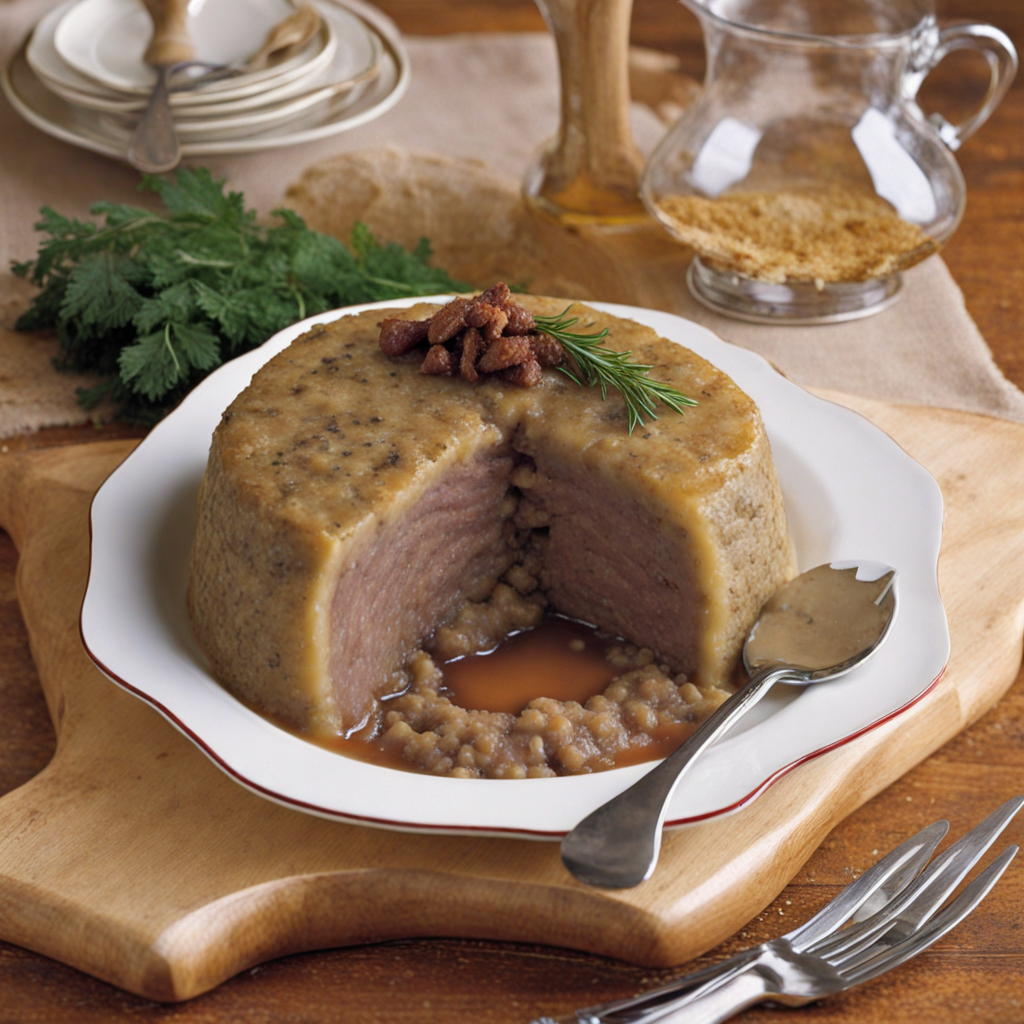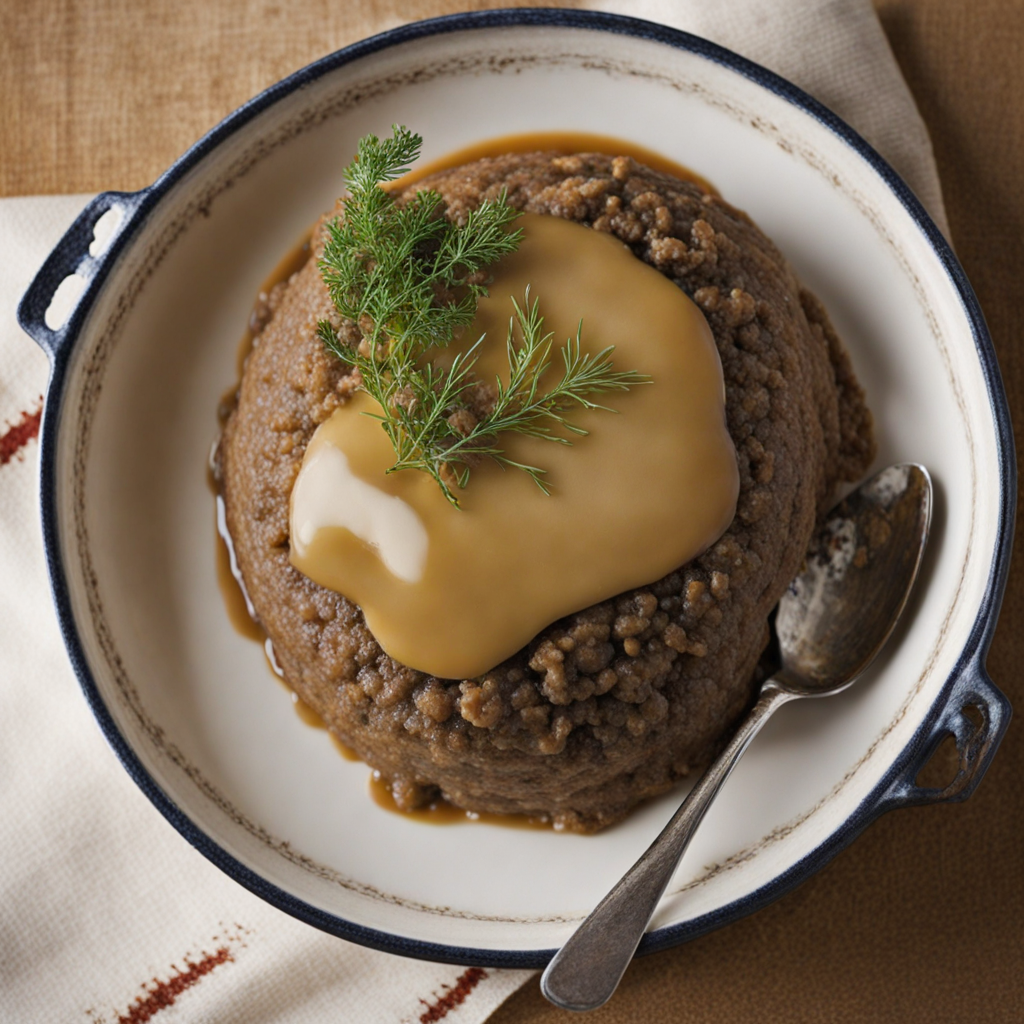Haggis
Haggis is a traditional Scottish dish that embodies the rich culinary heritage of the United Kingdom. At its core, haggis is a savory pudding made from sheep's offal, which includes the heart, liver, and lungs, finely minced and mixed with onions, oatmeal, suet, and an array of spices. This unique combination creates a hearty and flavorful dish that is often encased in the sheep's stomach, lending it a distinctive appearance. The texture is both coarse and creamy, while the spices provide a warm and aromatic depth that tantalizes the palate. Traditionally served with neeps (mashed turnips) and tatties (mashed potatoes), haggis is a centerpiece during celebrations, particularly on Burns Night, when Scots commemorate the poet Robert Burns. The dish is often accompanied by a dram of whisky, enhancing the experience with its earthy flavors. The contrast of the rich haggis with the sweet and buttery neeps and the creamy tatties creates a wonderful balance on the plate, making each bite a delightful exploration of taste and texture. For those adventurous enough to try haggis, the flavor is robust and hearty, reminiscent of a spiced meatloaf but with a more complex and earthy profile. The oatmeal adds a grounding element, while the spices impart warmth and a bit of heat, making it a comforting dish ideal for cold weather. Whether enjoyed in its traditional form or incorporated into modern recipes, haggis is a culinary experience that showcases the bold and hearty flavors of Scottish cuisine.
How It Became This Dish
The History of Haggis: A Culinary Icon of Scotland Haggis is a dish steeped in tradition and cultural significance, often recognized as the national dish of Scotland. Its origins are both intriguing and complex, reflecting the rustic roots of Scottish cuisine and the broader historical context of the British Isles. This exploration of haggis encompasses its origins, cultural significance, and its evolution through the centuries, revealing a dish that is as rich in flavor as it is in history. #### Origins: The Heart of Haggis The term "haggis" is believed to derive from the Old French word "haguis," which refers to a dish made from the entrails of a sheep. The earliest records of haggis can be traced back to the Roman period. The Romans, who invaded Britain around 43 AD, documented the consumption of various offal dishes consumed by the indigenous tribes. However, it is in Scotland that haggis truly found its identity. The earliest written mention of haggis appears in the 14th century, in "The Forme of Cury," a collection of recipes compiled by the chefs of King Richard II of England. Yet, it was in the Scottish highlands and lowlands that haggis became a staple, utilizing the whole animal in a sustainable manner. Traditionally, haggis is made from the sheep's heart, liver, and lungs, finely minced and mixed with oats, suet, spices, and stock, all encased in the sheep's stomach. This method of preparation was not only practical but also reflective of the Scots' resourcefulness in a landscape often harsh and unforgiving. #### Cultural Significance: The Soul of Scotland Haggis occupies a special place in Scottish culture, symbolizing the spirit of the nation. Its association with the poet Robert Burns, who penned the "Address to a Haggis" in 1786, has cemented its status as a cultural emblem. Every January 25, Scots around the world celebrate Burns Night, honoring the poet's legacy with a traditional supper that includes haggis, neeps (turnips), and tatties (potatoes). During the celebration, the haggis is ceremoniously piped in, and Burns' verses are recited, paying homage to the dish that encapsulates the essence of Scottish identity. Beyond Burns Night, haggis is also a dish of communal significance. Traditionally served at festive occasions, weddings, and gatherings, it fosters a sense of togetherness. The preparation of haggis is often a family affair, with recipes passed down through generations, ensuring that the dish retains its cultural roots while adapting to modern tastes. #### Development Over Time: From Peasant Fare to Gourmet Cuisine The 19th century marked a turning point for haggis as it began to evolve from a humble peasant dish into a culinary delicacy. The Industrial Revolution brought significant changes to Scotland, with urbanization leading to the growth of cities like Glasgow and Edinburgh. As people moved into urban areas, haggis became more accessible, with butchers and specialty shops offering pre-made versions. This accessibility contributed to its popularity, allowing it to transcend class boundaries. In the 20th century, the rise of the gourmet food movement further transformed haggis. Chefs began to experiment with the traditional recipe, incorporating contemporary techniques and flavors. While the classic preparation remains beloved, inventive variations emerged, including vegetarian and vegan haggis, made with lentils, beans, and a medley of spices. This adaptation reflects broader societal changes, as dietary preferences evolve and expand. Moreover, haggis has gained recognition on the international stage, often featured in Scottish restaurants and culinary festivals worldwide. Its reputation as a symbol of Scottish heritage has led to a resurgence in interest, both among locals and tourists seeking an authentic taste of Scotland. In recent years, haggis has been celebrated in various culinary competitions, showcasing the versatility and appeal of this traditional dish. #### Modern Interpretations: A Culinary Renaissance Today, haggis is no longer confined to traditional occasions. Innovative chefs have embraced the dish, crafting unique interpretations that push the boundaries of Scottish gastronomy. Haggis is now found in various forms, from haggis burgers and haggis-stuffed pastries to haggis bonbons and even haggis pizza. These modern adaptations reflect a broader trend in the culinary world, where chefs blend tradition with creativity to appeal to diverse palates. Despite these modern interpretations, the essence of haggis remains intact. The dish continues to embody the spirit of Scotland, celebrating its agricultural heritage and the ethos of 'waste not, want not.' It serves as a reminder of the resilience of Scottish culture, demonstrating how traditional foods can evolve while maintaining their core identity. #### Conclusion: A Dish of Heritage and Pride Haggis is more than just a dish; it is a symbol of Scottish heritage, resilience, and community. From its humble beginnings as a practical way to utilize every part of the animal to its current status as a gourmet delicacy, haggis has undergone a remarkable transformation. Its cultural significance, particularly in relation to Robert Burns and celebrations like Burns Night, ensures that haggis will remain a cherished part of Scotland's culinary landscape. As we look to the future, haggis stands as a testament to the power of food in shaping cultural identity. It continues to inspire chefs and home cooks alike, inviting them to honor tradition while embracing innovation. Whether enjoyed in its classic form or as part of a modern twist, haggis will always be a beloved emblem of Scotland, capturing the heart and soul of the nation in every savory bite.
You may like
Discover local flavors from United Kingdom







